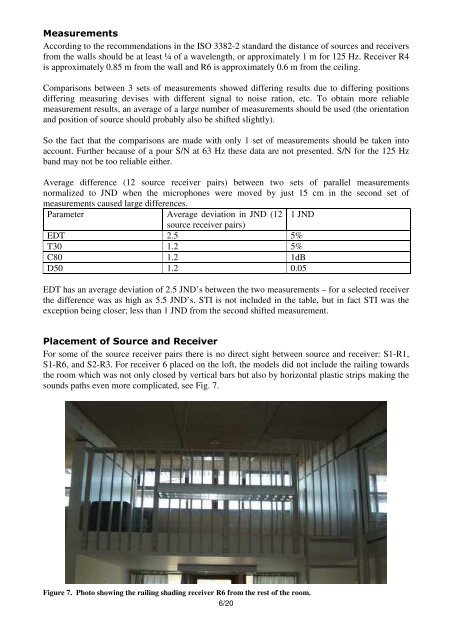Danish Acoustical Society Round Robin on room acoustic computer ...
Danish Acoustical Society Round Robin on room acoustic computer ...
Danish Acoustical Society Round Robin on room acoustic computer ...
Create successful ePaper yourself
Turn your PDF publications into a flip-book with our unique Google optimized e-Paper software.
Measurements<br />
According to the recommendati<strong>on</strong>s in the ISO 3382-2 standard the distance of sources and receivers<br />
from the walls should be at least ¼ of a wavelength, or approximately 1 m for 125 Hz. Receiver R4<br />
is approximately 0.85 m from the wall and R6 is approximately 0.6 m from the ceiling.<br />
Comparis<strong>on</strong>s between 3 sets of measurements showed differing results due to differing positi<strong>on</strong>s<br />
differing measuring devises with different signal to noise rati<strong>on</strong>, etc. To obtain more reliable<br />
measurement results, an average of a large number of measurements should be used (the orientati<strong>on</strong><br />
and positi<strong>on</strong> of source should probably also be shifted slightly).<br />
So the fact that the comparis<strong>on</strong>s are made with <strong>on</strong>ly 1 set of measurements should be taken into<br />
account. Further because of a pour S/N at 63 Hz these data are not presented. S/N for the 125 Hz<br />
band may not be too reliable either.<br />
Average difference (12 source receiver pairs) between two sets of parallel measurements<br />
normalized to JND when the microph<strong>on</strong>es were moved by just 15 cm in the sec<strong>on</strong>d set of<br />
measurements caused large differences.<br />
Parameter Average deviati<strong>on</strong> in JND (12 1 JND<br />
source receiver pairs)<br />
EDT 2.5 5%<br />
T30 1.2 5%<br />
C80 1.2 1dB<br />
D50 1.2 0.05<br />
EDT has an average deviati<strong>on</strong> of 2.5 JND’s between the two measurements – for a selected receiver<br />
the difference was as high as 5.5 JND’s. STI is not included in the table, but in fact STI was the<br />
excepti<strong>on</strong> being closer; less than 1 JND from the sec<strong>on</strong>d shifted measurement.<br />
Placement of Source and Receiver<br />
For some of the source receiver pairs there is no direct sight between source and receiver: S1-R1,<br />
S1-R6, and S2-R3. For receiver 6 placed <strong>on</strong> the loft, the models did not include the railing towards<br />
the <strong>room</strong> which was not <strong>on</strong>ly closed by vertical bars but also by horiz<strong>on</strong>tal plastic strips making the<br />
sounds paths even more complicated, see Fig. 7.<br />
Figure 7. Photo showing the railing shading receiver R6 from the rest of the <strong>room</strong>.<br />
6/20

















